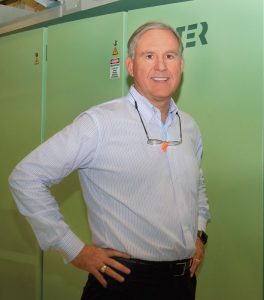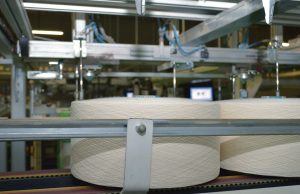
Parkdale Chairman and CEO Andy Warlick discusses the influence of automation on the spinning industry and its development at Parkdale.
TW Special Report
Gastonia, N.C.-based Parkdale Inc. has a long history as an early adopter of technology and as an investor in automation innovations, demonstrating a commitment to quality through automation. Today, spinning is one of the most automated manufacturing processes in the textile industry.
Textile World recently had the opportunity to discuss the history and development of automation in the spinning industry with Parkdale’s Chairman and CEO Anderson D. “Andy” Warlick.
TW: What about the spinning process specifically made the adoption of automation technologies possible?
Warlick: Ring spinning was and is very labor-intensive. The desire to reduce cost drove manufacturers to pursue automation. The resulting technology began with automated winding, then automated doffing of the ring spinning frames. Next was automated doffing and transport of roving and combing. Linking systems together like roving to spinning to winding has helped significantly reduce the handling cost.
TW: How did automation in the spinning industry develop?
Warlick: Automation in the spinning industry developed in countries that had higher wages than third world countries. It helped Western companies remain competitive.
TW: What was the first automated spinning process that Parkdale adopted?
Warlick: Automated winding was the first development we adopted at Parkdale. Next, we bought automated Schlafhorst open-end machines to replace our manual open-end spinning machinery. Then we invested in automated ring spinning doffers, then automated opening of our cotton. We then purchased automated combers with transport of the lap, automated cone packaging, robotic delivery of sliver cans. And today, we are installing robots that automatically spin or put up ends on our ring spinning machines.
TW: Was there any particular technology development that resulted in a big leap in spinning automation?
Warlick: Open-end spinning technology allowed the greatest leaps in automation and productivity. Open-end spinning created the opportunity for the best in the world to pursue the “lights out factory” in the 1990s. The sliver to yarn aspect of this technology allowed fewer processes that took up less space as well. If you went to an ITMA trade show during the 90s, there were more automation and monitoring companies exhibiting than there were at ITMA shows from 2000-2014!

TW: Are there any pinch points in automating the spinning process? For example, processes that are too variable or require a human touch?
Warlick: No pinch points in automating except cost.
TW: What were/are the biggest hurdles that had/have to be overcome?
Warlick: The biggest hurdles have been cost and availability. Once devalued currency became a competitive weapon for third world countries, the cost/labor benefit became steeper and many technology providers stopped working on automation technologies. Instead, they turned their attention to making less expensive manual machines that were demanded by countries taking advantage of cheap wages. In 1998, the currencies collapsed across Southeast Asia, and that was when our most important technology suppliers started the de-automation of machines.
TW: Where is automation focused today, and what impact does artificial intelligence (Al) have on automation?
Warlick: Automation has been focused on taking non-technical manual labor out. The textile industry has actually been a leader in AI in many ways over the past three decades. We have total plant monitoring and we have processes that make automated adjustments to the machinery to improve quality and eliminate defects. Plant conditions and electrical use have been monitored and controlled automatically for 40 years in Parkdale facilities.
TW: Is there any new technology, which if developed, could further advance or improve the spinning process?
Warlick: New developments in spinning need to focus on automating the ring spinning process — sliver to yarn, and bigger package distribution throughout the factory. Electrostatic spinning at high-speed that can emulate ring-spun yarn quality could be a remarkable improvement.
TW: Automation has always fascinated you. What are your views for the future of automation — both inside and outside of the textile industry?
Warlick: Automation will continue, particularly in the Western world where labor costs and labor availability are an issue. China’s wages have started to rise on the east coast and this has been a boon for automation. Many of our suppliers are starting to reinvest in automation since their demand and market is now larger than just the Western world.
I have invested in a Tesla to keep up with the technology. The improvements that have been made to the technology in just three years of ownership have been amazing. Our industry needs a Tesla and Elon Musk with ideas to drive exponential growth and change.
March/April 2021




